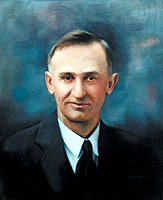Inducted in 2001
General Aviation Pioneer
1879 – 1954
Born in Iowa and growing up on a Kansas farm, Clyde Cessna exhibited an aptitude for mechanics and became an expert in repairing farm machinery and early automobiles. Later, he took charge of an automobile sales and service agency in Enid, Oklahoma.
Impressed by the simplicity and performance of early monoplanes, Cessna built his own and taught himself to fly it in 1911. Steadily improving this plane, he used it in exhibition flights throughout Kansas and Oklahoma. After moving to Wichita, he built the Cessna-Jones Six and Comet monoplanes and used them in aerial exhibitions until World War I.
In 1925, Cessna helped form a travel air manufacturing company to build biplanes and became its president. In 1926, he developed an advanced monoplane. Two models, the City of Oakland and the Woolorac, set transpacific records in 1927. Leaving travel air, he developed a cantilevered-wing monoplane, formed Cessna Aircraft Company and became its president and chief engineer. Production of his Model A series monoplane began in 1928 and was followed by a series of improved models, as well as by a variety of racing planes and low-cost primary gliders. After the plant was closed by the Depression, he and his son, Eldon, formed the Cessna Aeroplane Company and built the CR-1 Racer, which placed in three events of the 1932 National Air Races. Their CR-3 Racer set an international speed record in 1933. After he was re-elected president of Cessna Aircraft in 1934, the Model C-34 was introduced, which earned the title of “world’s most efficient aircraft.”
Cessna is remembered for his outstanding contributions to aviation in three areas: developing and demonstrating early monoplanes, founding and overseeing aircraft manufacturing companies, and producing high-efficiency general aviation aircraft.

